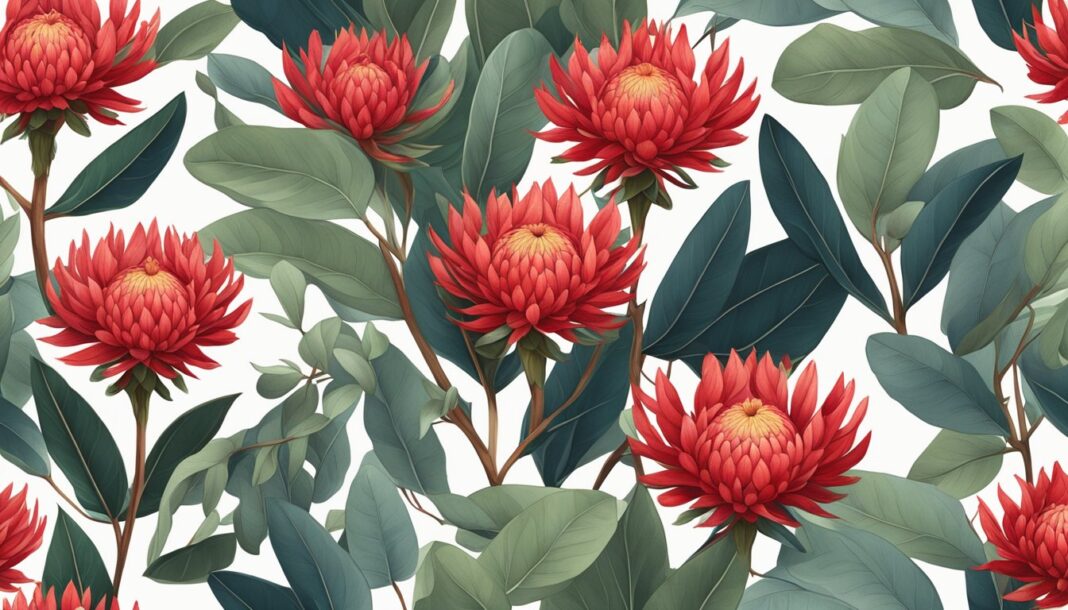Australian flowers such as the Waratah, Wattle, and Banksia offer a stunning display of nature’s beauty and cultural significance. These flowers not only enhance the landscape but also carry deep meanings, from strength and resilience to unity and new beginnings. Understanding these floral emblems can enrich your appreciation for Australia’s unique biodiversity.
The Waratah, with its striking red petals, stands as a powerful symbol of strength, reflecting the enduring spirit of the Australian landscape. In contrast, the golden Wattle, with its fluffy blooms, represents unity and remembrance, connecting people to their heritage. Meanwhile, the Banksia’s unique cone-shaped flowers signify rebirth and the promise of new beginnings.
Exploring these flowers can provide insight into Australia’s natural heritage and cultural identity. By appreciating their beauty and symbolism, you gain a deeper connection to the environment and the stories it holds.
Key Flowers of Australia
Australia is home to a diverse range of unique flowers, each with their own significance. Two key flowers are the Waratah and the Wattle, which are not only visually striking but also carry deep cultural meanings.
Waratah
The Waratah features bold red blooms that can grow up to 10 centimeters in diameter. They are renowned for their resilience in harsh conditions, symbolizing strength. This flower is native to New South Wales and thrives in well-drained soils.
Key Characteristics:
- Scientific Name: Telopea speciosissima
- Blooming Season: Primarily in spring
- Habitat: Prefers coastal heath and woodland areas
In addition to their striking appearance, Waratahs hold cultural significance for Indigenous Australians. They often represent enduring spirit and are used in various ceremonies.
Wattle
Wattle flowers are characterized by their vibrant yellow, fluffy blooms that often appear in clusters. As Australia’s national floral emblem, they symbolize unity and remembrance.
Key Facts:
- Scientific Name: Acacia
- Blooming Season: Throughout the year, depending on the species
- Habitat: Common in various environments, from forests to deserts
Wattle is particularly significant during special events, such as Australia Day. The flower serves as a reminder of the nation’s identity and resilience.
Floral Symbols and Meanings
Australian flowers carry deep meanings that reflect the culture and values of the country. Each bloom symbolizes various qualities, providing insights into the emotional and historical significance attributed to them.
Unity and Remembrance
The Wattle flower, with its vibrant yellow fluff, represents unity and remembrance. It is deeply entwined with Australian identity and is often associated with Anzac Day, honoring the sacrifices made by soldiers. Wattle flowers bloom in late winter and spring, symbolizing hope and the joy of coming together after hardship.
- Cultural Significance: The Wattle is Australia’s national floral emblem, featured in numerous ceremonies and events.
- Symbolism: These flowers remind you of the importance of community and collective memory, fostering connection and support.
Strength and Resilience
The Waratah, known for its striking red petals, symbolizes strength and resilience. Growing in varied environments, this flower thrives despite challenging conditions, making it a powerful emblem of endurance.
- Environmental Adaptability: The Waratah flourishes in diverse habitats, showcasing its strength against adversity.
- Cultural Reflection: This flower often embodies the spirit of the Australian people, encouraging you to embrace resilience in the face of challenges.
Botanical Characteristics
The following sections will provide detailed insights into the botanical characteristics of Banksia, highlighting its unique features and biological significance.
Banksia
Banksia plants are part of the Proteaceae family, which is well-known for their distinctive flowering habits. They typically exhibit elongated, woody, cone-shaped flower spikes that can be quite striking in appearance.
Leaves are generally narrow, hard, and serrated, which helps to reduce water loss in their native habitats. The foliage varies from light green to dark green, often with a glossy finish.
Flowers emerge in clusters and are often rich in nectar, attracting a variety of pollinators such as birds and insects. The flowering season varies by species but predominantly occurs in late winter to early spring.
Fruit forms as woody capsules that release seeds when mature. This feature aids in regrowth after bushfires, showcasing Banksia’s adaptation to the Australian landscape.
Frequently Asked Questions
Understanding specific aspects of the Waratah and its significance can enhance your appreciation for this unique Australian flower. Here are some common questions related to the Waratah.
What does the Waratah flower symbolize?
The Waratah flower symbolizes strength and resilience. Its vibrant red color represents passion and courage, making it a significant emblem in Australian culture.
In which habitats can the Waratah be found?
Waratah plants thrive in a variety of habitats, including heathlands and open forests. They typically grow in areas with well-drained soil and can often be found in coastal regions.
Which Australian flower is associated with loyalty and friendship?
The Wattle flower, characterized by its yellow, fluffy blooms, is associated with loyalty and friendship. It holds a special place in Australian symbolism and culture.
When is the blooming season for Waratah flowers?
Waratah flowers typically bloom from late winter to spring, specifically from August to November. This seasonal display contributes to their popularity among gardeners and nature enthusiasts.
What are some notable spiritual meanings attributed to Waratah flowers?
In spiritual contexts, Waratah flowers are seen as symbols of new beginnings and transformation. They are often associated with personal growth and strength during challenging times.
Where can one find information about Waratah plants for purchase?
You can find information about purchasing Waratah plants at local nurseries and garden centers. Additionally, many online retailers specialize in native Australian plants, offering a variety of options.



